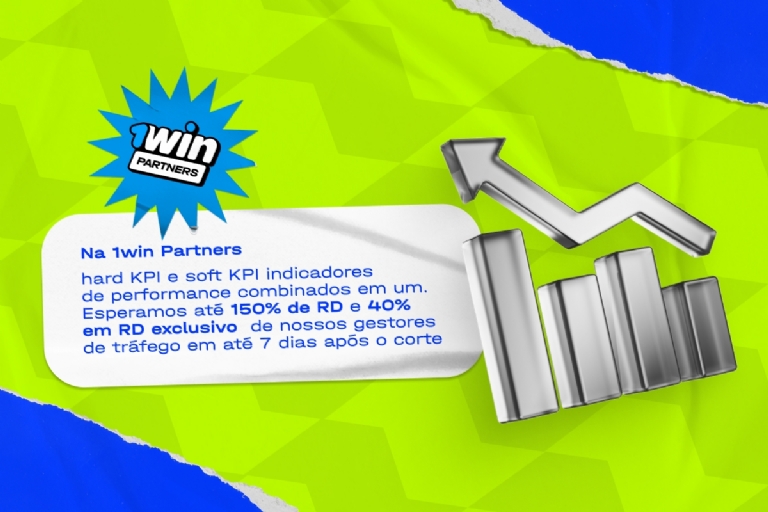

Andrew, the leader of the CPA CIS and Africa team, demonstrates how a webmaster can transition from the challenging path of "my traffic is consistently paid" to "I work with a higher CPA." To achieve this, we will understand the concept of KPIs in iGaming, calculate returns, and consider favorable conditions for a rate increase.
Follow us on social media to stay updated with everything happening at 1win Partners - Telegram, Youtube, Instagram, Threads, Twitter.
What are the different types of KPIs?
While the thresholds for minimum payment and payment increases are far apart, they are still connected. So, let's first understand KPIs: we will consider what the concept includes and what it can be.

Each offer holder sets their own KPI, which determines the traffic that will be processed. Let's highlight the main indicators:
Player Activity - When analyzing, the manager observes the number of repeated deposits (RD - ReDeposit) and the unique RD.
Average Player Check - Calculated as: Total deposits / Number of deposits. An advertiser may include in the KPI an average check of up to 0.5 of the first week's CPA rate.
KPIs can also be divided into flexible and rigid KPIs:
This means that if the traffic does not meet the flexible KPI during the trial period but meets the hard KPI, those FTDs (First Time Deposits) will still be paid. However, further collaboration will be in question.
Some may say this is tough. But I would respond: we do not pull numbers out of thin air; they are based on the average performance of our sites. This means it is being exceeded and even surpassed. Therefore, the KPI is more than scalable. Test different approaches, check your stats with your manager and in your personal account, and you will be satisfied (with generous limits and payments).
More and more advertisers are moving towards a single KPI, as the company is primarily interested in meeting flexible metrics. And this is not a whim, but a common reluctance to work in the negative, paying for traffic that will not generate revenue.

How not to burn out as a KPI?
The arbitration market recalls dozens of cases where webmasters were "deceived" regarding payment. The accusations varied, some fair and others not so much. I won't judge anyone; it's much more useful to understand how to avoid getting into such controversial situations:
* Make it a rule to evaluate your traffic at regular intervals. First and foremost, I advise you to pay attention to the average check (with and without withdrawals), GGR, player activity (RD and URD), and you can also ask your manager for a cutoff analysis. This way, you'll always know which KPIs you're not meeting.
* Take an interest in metrics as you scale. Quality can deteriorate as volume increases, so it's especially important to keep an eye on it. Don't ask your manager for feedback on traffic every day—once a week is ideal. Don't hesitate to ask questions. For example, what do you need to work on, or which groups are better to set up?
* Compare the groups and the quality of traffic coming from them. This way, you can identify the winning creatives, CTAs, keys, and other components.
How does the advertiser decide the bid can be increased?
The above points are necessary just for the traffic to simply be paid. Now let's move on to the most interesting part: the conditions for increasing the rate.
The main indicator for us as advertisers is the return on traffic. In our calculations, we use the following data:
GGR (Gross Gaming Revenue) - Gross Gaming Revenue. It shows the amount of money earned by online casinos from players' losses.
GGR = Bet Amount - Payouts to the player.
You can see the GGR in your 1win Partners account in the statistics section. The system automatically calculates and displays the difference between players' losses and winnings in the "Total Difference" column.
NGR (Net Gaming Revenue) - Net Gaming Revenue. It shows the amount of money left after deducting all costs and taxes.
NGR = Bet Amount - (Payouts to the player + Bonus payments + Administration fee).
Each advertiser sets their payback period. One thing is constant: investments (funds spent on CPA payments) must generate profit.
Payback is calculated using the formula GGR / CAC x 100%, where CAC (Customer Acquisition Cost) is the CPA rate.
Example:
In October 2023, a webmaster brought in 50 players, with a qualification payment of $30. In one month, their GGR was $650. Therefore, this results in:
CAC = 50 x $30 = $1,500
GGR = $650
In one month, the traffic compensated 43.3% ($650 / $1,500 x 100%), which is a good indicator, meaning you can ask for a higher bid.
A favorable sign can be considered if, with a CPA of $30 in the first week, the average player brought in $10. If the average player brings in the same $10 for the advertiser in the first week, but the webmaster's bid is already $60, you shouldn't expect more.
Conclusion
In summary, KPIs are an indicator of average quality, and to expect a bid increase, your traffic must be above average. If you're moving away from a standard CPA, your metrics fit the ROI segmentation, and you can justify it, talk to your manager!
This article is not a ready-made solution or a "magic button." All the tips written above are there for you to evaluate your traffic yourself and find the arguments you can present. As they say, those who get it, get it.
Any questions or want to start working with 1win Partners then write to me on Telegram, and let's talk.
Source: 1win Partners